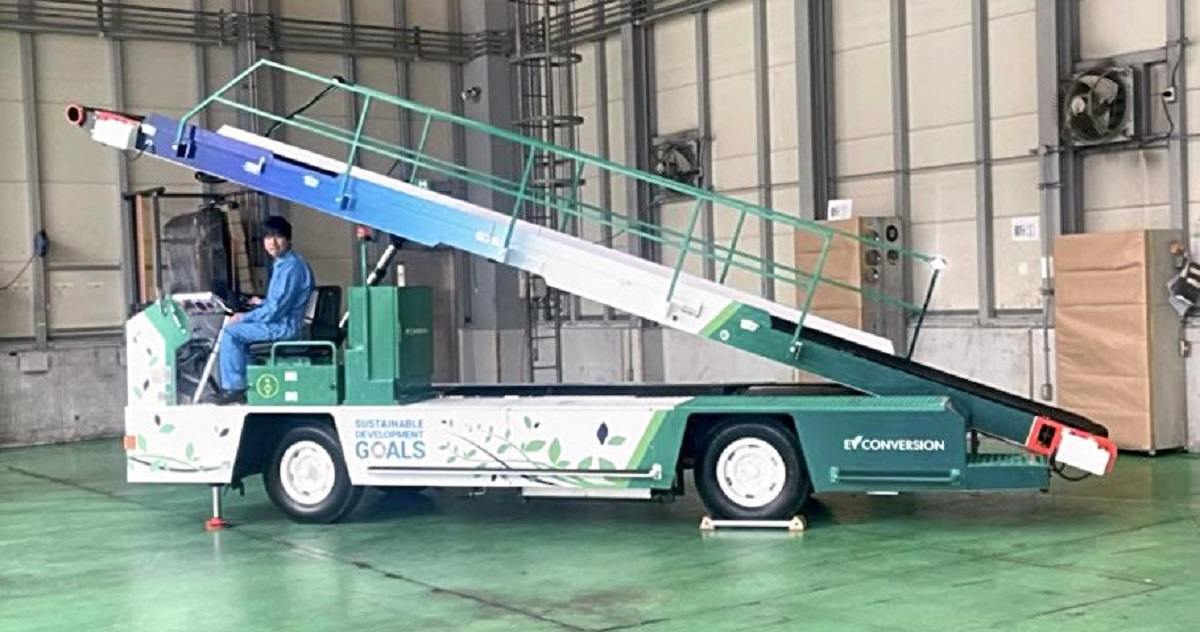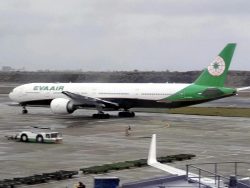Airport Service Vehicles Increasingly Replaced with EVs; Airline Industry Eager to Avoid ‘Flight Shame’ Over CO2

A converted EV belt loader owned by ANA group company is seen in May in Ota Ward, Tokyo.
13:47 JST, July 2, 2024
With service vehicles said to account for nearly 10% of CO2 emissions from airports, efforts to decarbonize airports are increasingly underway.
Currently, about 13,000 airport service vehicles are in operation across the nation, most of them powered by diesel. Electric vehicles and other types with zero carbon dioxide emissions only make up 6% of all airport service vehicles in Japan.
ANA Motor Service Co., a company belonging to ANA Group, announced in May it had converted one of its diesel-engine belt loaders to an EV. Used to move baggage on and off aircraft, the loader was originally slated for disposal. Now, it can be charged via a general power outlet.
Its power source for all operations, such as driving and loading and unloading cargo, will be switched from diesel to electricity.
Since most electric service vehicles are produced in other countries, there are concerns over maintaining them. Also, rising prices due to the weak yen prevent their wider use in Japan.
“Decarbonization is the mission of the entire aviation industry. We want to contribute to that goal,” an official at ANA Motor Service said. The company will convert more diesel-powered vehicles into EVs going forward.
According to the Land, Infrastructure, Transport and Tourism Ministry, electric service vehicles are used at Haneda Airport to load, unload and transport baggage and cargo in areas restricted to airport staff. Six EVs are reportedly being used to ascertain the total amount of electricity consumed and what facilities and equipment are needed to operate them.
Using these EVs is also expected to reduce CO2 emissions by 22 tons a year.
At Shizuoka Airport, long-distance service vehicles have been replaced with EVs to determine each vehicle’s travel distance on a normal charge, as well as how long it takes to charge them. Whether quick charges using special equipment are necessary will also be determined.
At Kumamoto Airport, EVs will be used as inspection vehicles for navigation light that have been in use for about 20 years.
The large amounts of CO2 emitted by the aviation industry have drawn harsh criticism overseas, expressed by the term “flight shame.” This year, the U.K. airline British Airways announced that more than 90% of its vehicles at London’s Heathrow Airport would be replaced with EVs and other vehicles operating on synthetic fuels.
Many countries are accelerating efforts to reduce CO2 emissions from airports. According to a senior official at the transport ministry, this is due to concerns that a delay in the decarbonization of certain airports could cause airlines to not use them.
There are still many challenges ahead. For example, as airports do not currently have additional power capacity available, switching all service vehicles to EVs will require airports to make large investments to enhance transmission lines and other facilities.
"Business" POPULAR ARTICLE
-

Japan Govt Adopts Measures to Curb Mega Solar Power Plant Projects Amid Environmental Concerns
-

Core Inflation in Tokyo Slows in December but Stays above BOJ Target
-

Major Japan Firms’ Average Winter Bonus Tops ¥1 Mil.
-

Institute: 2026 Condo Supply in Tokyo Metropolitan Area Forecast to Increase by 2.2%
-

Mcdonald’s, Starbucks in Japan Move Away from Paper Straws Amid Customer Dissatisfaction
JN ACCESS RANKING
-

Japan Govt Adopts Measures to Curb Mega Solar Power Plant Projects Amid Environmental Concerns
-

Core Inflation in Tokyo Slows in December but Stays above BOJ Target
-

Major Japan Firms’ Average Winter Bonus Tops ¥1 Mil.
-

Tokyo Zoo Wolf Believed to Have Used Vegetation Growing on Wall to Climb, Escape; Animal Living Happily after Recapture
-

JAL, ANA Cancel Flights During 3-day Holiday Weekend due to Blizzard
























